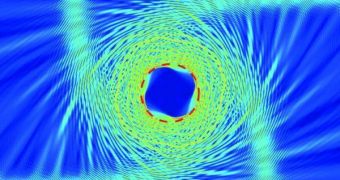Albert Einstein's theory of general relativity essentially united Isaac Newton's law of universal gravitation with his own theory of special relativity, thus explaining the properties of gravity through the geometry of space and time. He was the first to demonstrate that massive objects in the Universe, including the Sun, black holes and supernovas, influence the fabric of space-time through gravity. Now, his calculations will be used to set the basis for a new investigation method that could bring the study of general relativity to the table-top level.
In the past, his theory was used to infer, and later demonstrate and confirm, space events such as the presence of small disturbances in Mercury's orbit around the Sun, gravitational lensing, as well as our star's ability to bend light coming in from distant celestial bodies, by attracting it towards the center of mass. Other interactions between light (made up of particles called photons) and matter have also been thoroughly observed, or just hinted at using Einstein's work.
At this point, US Department of Energy's (DOE) Lawrence Berkeley National Laboratory (LBNL) faculty scientist Xiang Zhang proposes that the theory be used not on observations of the Sun, but of artificially created optical materials, which have the ability to bend light depending on their design. This means that those seeking to study such phenomena will no longer have to spend countless hours on telescopes, but could use relatively small-sized equipments that fit on an average laboratory table.
“We propose a link between the newly emerged field of artificial optical materials to that of celestial mechanics, thus opening a new possibility to investigate astronomical phenomena in a table-top laboratory setting. We have introduced a new class of specially designed optical media that can mimic the periodic, quasi-periodic and chaotic motions observed in celestial objects that have been subjected to complex gravitational fields,” Zhang explains, quoted by ScienceDaily.
“If we twist our optical metamaterial space into new coordinates, the light that travels in straight lines in real space will be curved in the twisted space of our transformational optics. This is very similar to what happens to starlight when it moves through a gravitational potential and experiences curved space-time. This analogue between classic electromagnetism and general relativity, may enable us to use optical metamaterials to study relativity phenomena such as gravitational lens,” he further adds.
A paper detailing his idea is published in the latest online issue of the journal Nature Physics.

 14 DAY TRIAL //
14 DAY TRIAL //